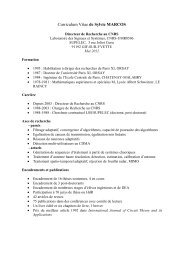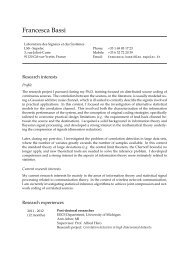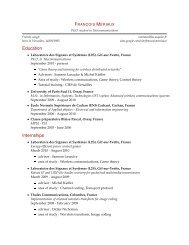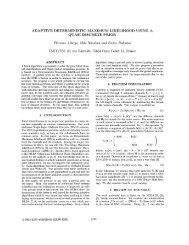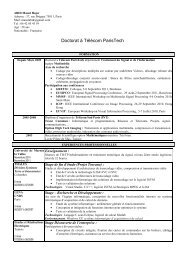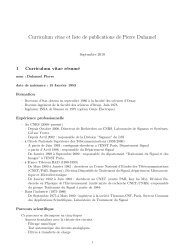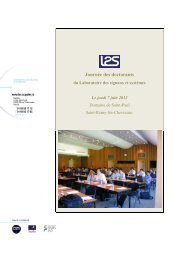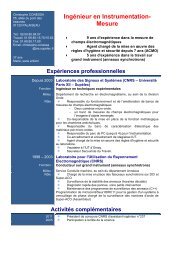THÈSE DE DOCTORAT Ecole Doctorale « Sciences et ...
THÈSE DE DOCTORAT Ecole Doctorale « Sciences et ...
THÈSE DE DOCTORAT Ecole Doctorale « Sciences et ...
You also want an ePaper? Increase the reach of your titles
YUMPU automatically turns print PDFs into web optimized ePapers that Google loves.
S(t k+1 ) = S(t − k+1 ) + τ kC T C,<br />
(4b)<br />
such that, for all k ≥ 0,<br />
λ(t k+1 ) = M(τ k , t k+1 )λ(t − k+1 ),<br />
(4c)<br />
ˆθ(t k+1 ) = ˆθ(t k ) + ∆(t k+1 )(y(t k+1 ) − Cˆx(t − k+1<br />
)), (4d)<br />
with, ∆(t k+1 )=<br />
1+ǫ‖λ(t − k+1 )T C T Σ(t − k+1 )Cλ(t− k+1 )‖λ(t− k+1 )T C T<br />
×Σ(t − k+1 ), and M(τ k, t k+1 ) = ( I n − ρτ k S −1 (t k+1 )C T C ) .<br />
The notation ˆx ∈ R n and ˆθ ∈ R l respectively denote<br />
the estimate of the state, x, and the estimate of the unknown<br />
vector param<strong>et</strong>er θ, S(t) ∈ R n×n is the so-called<br />
observation gain, λ ∈ R n , Σ ∈ C(R, R p×p ) is symm<strong>et</strong>ric<br />
positive definite for all t, and µ, ǫ ∈ R + , ρ ∈ [1, ∞)<br />
are some design param<strong>et</strong>ers. Note that the existence of<br />
the inverse of matrix S will be ensured in the following.<br />
The initial conditions are denoted ˆx 0 ∈ R n , S 0 > 0<br />
symm<strong>et</strong>ric, λ 0 ∈ R n and ˆθ 0 ∈ R l .<br />
The observer (3a-d)-(4a-d) is composed of a predictor<br />
part (3a-d) and a correction one (4a-d). During<br />
[t k , t k+1 ), the state estimate ˆx has the same dynamics<br />
than system (1) but using the estimate of the unknown<br />
variable, ˆθ, that is kept constant (3d). As commonly<br />
done for high gain observers, the matrix S is defined<br />
as the solution of the differential equation (3b), except<br />
that a term of the form C T C is usually added in order to<br />
ensure S to be positive definite, see for example in [21].<br />
At each sampling instants, observer trajectory is corrected<br />
taking into account the available measure (4a).<br />
Thank to (4b), conditions on the inputs and restriction<br />
on τ, it will be shown that matrix S remains positive<br />
definite. The dynamics of ˆθ are defined by a least mean<br />
square law (4d), that will guarantee the convergence of<br />
the estimate to the true value, under some persistent<br />
excitation conditions. The usefulness of variable λ will<br />
be shown in the stability analysis, like in [23,6].<br />
Remark 1 If the param<strong>et</strong>er vector θ is equal to zero,<br />
system (3a-d)-(4a-d) has the same form than in [21].<br />
The dynamical equation satisfied by the state observation<br />
error, e = x−ˆx, is, in view of (1), (3a-d) and (4a-d),<br />
for k ≥ 0:<br />
ė(t) = A(u)e(t) + φ(u)˜θ(t k ), t ∈ [t k , t k+1 ),<br />
ǫ<br />
(5a)<br />
e(t k+1 )=(M(τ k , t k+1 )−λ(t k+1 )∆(t k+1 C))e(t − k+1 ), t = t k+1.<br />
(5b)<br />
The following persistent excitation condition is assumed<br />
to hold for system (1) in order to guarantee the identifiability<br />
of vector θ [23,6].<br />
Hypothesis 2 L<strong>et</strong> λ(·) ∈ R n×s be the matrix solution<br />
of the impulsive ordinary differential equation (3c)-(4c).<br />
The matrix λ(·) is persistently excited so that there exist<br />
k 1 ∈ N, δ > 0 and Σ(·) ∈ C([t 0 , ∞), R p×p ) a timedependent<br />
bounded symm<strong>et</strong>ric positive definite matrix,<br />
∑ k+k1<br />
j=k λT (t − j )CT Σ(t j )Cλ(t − j ) ≥ δI n. (6)<br />
Before stating the main theorem, some preliminary definition<br />
and results are required.<br />
Definition 3 Consider system, for t ∈ [t 0 , ∞):<br />
ẋ(t) = A(u)x(t),<br />
y(t) = Cx(t),<br />
(7)<br />
and the transition matrix Ψ u (·, t 0 ) associated to system<br />
(7), such that Ψ u (t 0 , t 0 ) = I n , the bounded input u is said<br />
to be regularly persistent if there exist t 1 , t 2 ∈ [t 0 , ∞),<br />
α ∈ R + , such that, for all t ≥ t 2 ,<br />
∫ t+t1<br />
t<br />
Ψ T u (s, t 0)C T CΨ u (s, t 0 ) ds ≥ αI n . (8)<br />
As mentioned in Introduction, regularly persistent inputs<br />
are the class of inputs that guarantee the system to<br />
be observable. For more d<strong>et</strong>ails, see [8,9,14].<br />
Remark 4 In practice, condition (8) can be checked offline,<br />
when u(t) is known for all t ∈ [t 0 , ∞), using numerical<br />
tools for approximating the integral term. Thus, coefficients<br />
t 1 and α are obtained off-line in order to derive<br />
a sampling period that satisfies the bound given in (9).<br />
4.2 Technical results<br />
The following proposition guarantees that matrix S is<br />
positive definite for any t ∈ [t 0 , ∞), under conditions on<br />
the types of inputs applied to the system and τ.<br />
Proposition 5 L<strong>et</strong> u be a regularly persistent input for<br />
system (1), for all µ ≥ ξ where ξ = 2 sup t≥t0 ‖A(u(t))‖,<br />
if τ ≤ ¯τ, where ¯τ is the unique positive term such that<br />
¯τ =<br />
αe−ξ(t 1 +¯τ)<br />
2ξ‖C T C‖(t , then, for all S(t 1+¯τ) 0) symm<strong>et</strong>ric positive<br />
definite, there exist constants β 1 , β 2 ∈ R + such that, for<br />
t ∈ [t 0 , ∞),<br />
β 1 I n ≤ S(t) ≤ β 2 I n .<br />
The proof of Proposition 5 can be found in [21].<br />
Remark 6 a) Since considered inputs belong to a compact<br />
s<strong>et</strong> ,D, and because A is continuous, ξ is well defined.<br />
b) There always exists such a ¯τ ; indeed writing condition<br />
¯τ =<br />
αe−ξ(t 1 +¯τ)<br />
2ξ‖C T C‖(t as 2ξ ∥ 1+¯τ) C T C ∥ (t1 + ¯τ)¯τ = αe −ξ(t1+¯τ) ,<br />
loosely speaking it is clear that, for positive values of ¯τ,<br />
3



